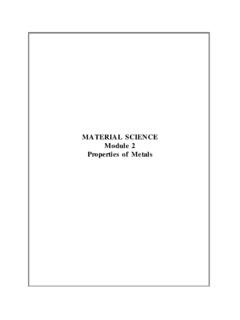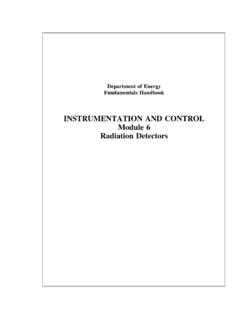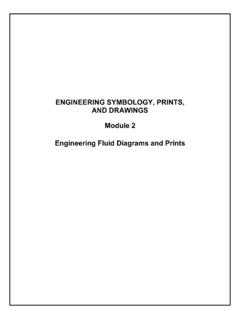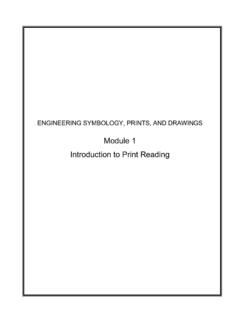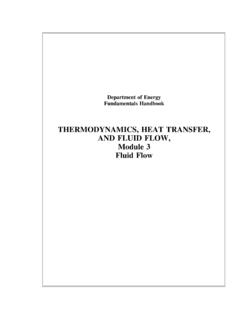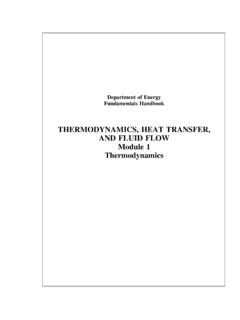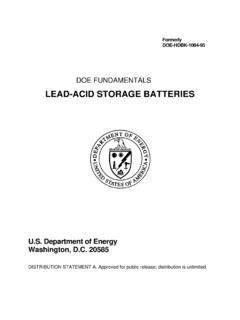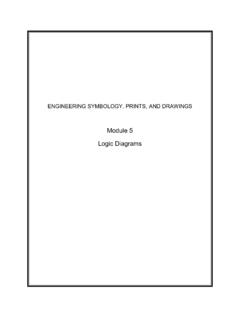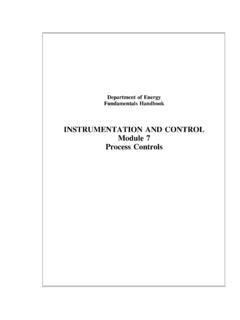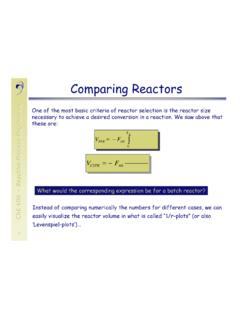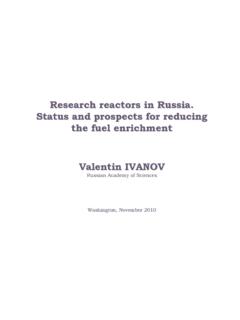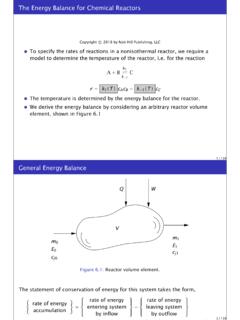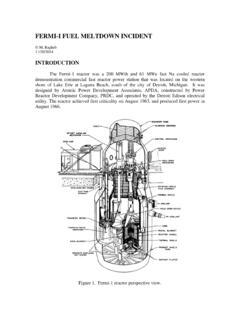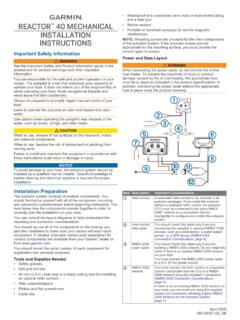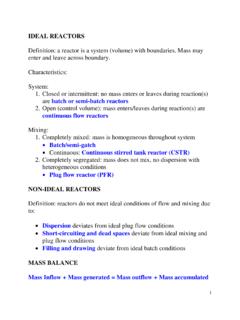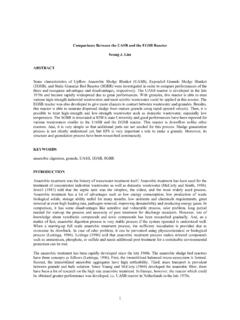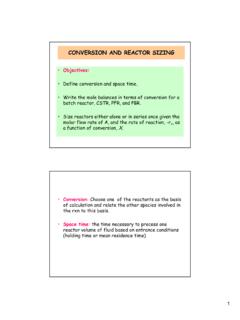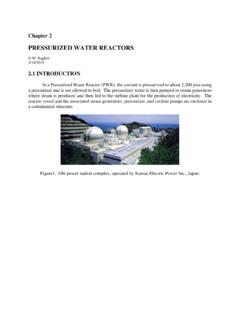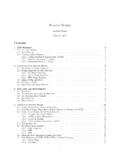Transcription of Module 3 Reactor Theory (Nuclear Parameters) - NTC Sites
1 nuclear PHYSICS AND Reactor Theory DOE Fundamentals nuclear PHYSICS AND Reactor Theory Module 3 reactor theory ( nuclear parameters ) nuclear PHYSICS AND Reactor Theory i TABLE OF CONTENTS T able of Co nte nts TABLE OF CONTENTS .. i LIST OF FIGURES .. iii LIST OF TABLES .. iii REFERENCES ..iv OBJECTIVES .. v NEUTRON LIFE CYCLE .. 1 Infinite Multiplication Factor, k .. 2 Four Factor Formula .. 2 Fast Fission Factor, (e) .. 3 Resonance Escape Probability, (p).. 3 Thermal Utilization Factor, (I).. 4 Reproduction Factor, ( ) .. 6 Effective Multiplication Factor .. 8 Fast Non-Leakage Probability (L) .. 9 Thermal Non-Leakage Probability (L t) .. 9 Six Factor Formula .. 10 Neutron Life Cycle of a Fast Reactor .. 13 Summary .. 14 REACTIVITY .. 17 Application of the Effective Multiplication Factor .. 17 Reactivity .. 18 Units of Reactivity .. 18 Reactivity Coefficients and Reactivity Defects .. 20 Summary .. 21 REACTIVITY COEFFICIENTS .. 22 Moderator Effects .. 22 Moderator Temperature Coefficient.
2 25 Fuel Temperature Coefficient .. 25 Pressure Coefficient .. 26 nuclear PHYSICS AND Reactor Theory ii Void 27 Summary .. 28 NEUTRON POISONS .. 30 Fixed Burnable Poisons .. 30 Soluble Poisons .. 31 Non-Burnable Poisons .. 31 Summary .. 33 XENON .. 34 Fission Product Poisons .. 34 Production and Removal of Xenon-135 .. 35 Xenon-135 Response to Reactor Shutdown .. 38 Xenon-135 Oscillations .. 40 Xenon-135 Response to Reactor Power Changes .. 40 Summary .. 42 SAMARIUM AND OTHER FISSION PRODUCT POISONS .. 44 Production and Removal of Samarium-149 .. 44 Samarium-149 Response to Reactor Shutdown .. 46 Other Neutron Poisons .. 47 Summary .. 48 CONTROL RODS .. 49 Selection of Control Rod Materials .. 49 Types of Control Rods .. 50 Control Rod Effectiveness .. 51 Integral and Differential Control Rod Worth .. 51 Rod Control Mechanisms .. 56 Summary .. 56 nuclear PHYSICS AND Reactor Theory iii LIST OF FIGURES Figure 1 Neutron Life Cycle with keff = 1 .. 11 Figure 2 Effects of Over and Under Moderation on keff.
3 24 Figure 3 Effect of Fuel Temperature on Resonance Absorption Peaks .. 26 Figure 4 Equilibrium I-135 and Xe-135 Concentrations Versus Neutron Flux .. 37 Figure 5 Xenon-135 Reactivity After Reactor Shutdown .. 39 Figure 6 Xenon-135 Variations During Power Changes .. 41 Figure 7 Behavior of Samarium-149 in a Typical Light Water Reactor .. 47 Figure 8 Effect of Control Rod on Radial Flux Distribution .. 51 Figure 9 Integral Control Rod Worth .. 52 Figure 10 Differential Control Rod Worth .. 53 Figure 11 Rod Worth Curves for Example Problems .. 53 Figure 12 Rod Worth Curves From Example 3 .. 56 LIST OF TABLES Table 1 Average Number of Neutrons Liberated in Fission .. 7 nuclear PHYSICS AND Reactor Theory iv REFERENCES Foster, Arthur R. and Wright, Robert L. Jr., Basic nuclear Engineering, 4th Edition, Allyn and Bacon, Inc., 1983. Jacobs, , Kline, , and Remick, , Basic Principles of nuclear Science and Reactors, Van Nostrand Company, Inc.
4 , 1960. Kaplan, Irving, nuclear Physics, 2nd Edition, Addison-Wesley Company, 1962. Knief, Ronald Allen, nuclear Engineering: Theory and Practice of Commercial nuclear Power, 2nd Edition, McGraw-Hill, 1992. Lamarsh, John R., Introduction to nuclear Engineering, 3rd Edition, Addison-Wesley Company, 2001. Lamarsh, John R., Introduction to nuclear Reactor Theory , American nuclear Society, 2002. Knolls Atomic Power Lab, Nuclides and Isotopes: Chart of the Nuclides, 17th Edition, Knolls Atomic Power Lab, 2010. Academic Program for nuclear Power Plant Personnel, Volume III, Columbia, MD, General Physics Corporation, Library of Congress Card #A 326517, 1982. Glasstone, Samuel, Sourcebook on Atomic Energy, 3rd Edition, Robert F. Krieger Publishing Company, Inc., 1979. Glasstone, Samuel and Sesonske, Alexander, nuclear Reactor Engineering, 4th Edition, Van Nostrand Reinhold Company, 1994. nuclear PHYSICS AND Reactor Theory v OBJECTIVES TERMINAL OBJECTIVE Using appropriate references, DESCRIBE the neutron life cycle discussed in this Module .
5 ENABLING OBJECTIVES DEFINE the following terms: a. Infinite multiplication factor, k b. Effective multiplication factor, keff c. Subcritical d. Critical e. Supercritical DEFINE each term in the six factor formula using the ratio of the number of neutrons present at different points in the neutron life cycle. Given the macroscopic cross sections for various materials, CALCULATE the thermal utilization factor. Given microscopic cross sections for absorption and fission, atom density, and v, CALCULATE the reproduction factor. Given the numbers of neutrons present at the start of a generation and values for each factor in the six factor formula, CALCULATE the number of neutrons that will be present at any point in the life cycle. LIST physical changes in the Reactor core that will have an effect on the thermal utilization factor, reproduction factor, or resonance escape probability. EXPLAIN the effect that temperature changes will have on the following factors: a.
6 Thermal utilization factor b. Resonance escape probability c. Fast non-leakage probability d. Thermal non-leakage probability Given the number of neutrons in a Reactor core and the effective multiplication factor, CALCULATE the number of neutrons present after any number of generations. DEFINE the term reactivity. CONVERT between reactivity and the associated value of keff. nuclear PHYSICS AND Reactor Theory vi CONVERT measures of reactivity between the following units: a. k/k c. 10-4 k/k % k/k d. Percent millirho (pcm) EXPLAIN the relationship between reactivity coefficients and reactivity defects. TERMINAL OBJECTIVE From memory, EXPLAIN how reactivity varies with the thermodynamic properties of the moderator and the fuel. ENABLING OBJECTIVES EXPLAIN the conditions of over moderation and under moderation. EXPLAIN why many reactors are designed to be operated in an under moderated condition. STATE the effect that a change in moderator temperature will have on the moderator to fuel ratio.
7 DEFINE the temperature coefficient of reactivity. EXPLAIN why a negative temperature coefficient of reactivity is desirable. EXPLAIN why the fuel temperature coefficient is more effective than the moderator temperature coefficient in terminating a rapid power rise. EXPLAIN the concept of Doppler broadening of resonance absorption peaks. LIST two nuclides that are present in some types of Reactor fuel assemblies that have significant resonance absorption peaks. DEFINE the pressure coefficient of reactivity. EXPLAIN why the pressure coefficient of reactivity is usually negligible in a Reactor cooled and moderated by a subcooled liquid. DEFINE the void coefficient of reactivity. IDENTIFY the moderator conditions under which the void coefficient of reactivity becomes significant. TERMINAL OBJECTIVE Without references, DESCRIBE the use of neutron poisons. nuclear PHYSICS AND Reactor Theory vii ENABLING OBJECTIVES DEFINE the following terms: a. Burnable poison b.
8 Non-burnable poison c. Chemical shim EXPLAIN the use of burnable neutron poisons in a Reactor core. LIST the advantages and disadvantages of chemical shim over fixed burnable poisons. STATE two reasons why fixed non-burnable neutron poisons are used in Reactor cores. STATE an example of a material used as a fixed non-burnable neutron poison. TERMINAL OBJECTIVE Without references, DESCRIBE the effects of fission product poisons on a Reactor . ENABLING OBJECTIVES LIST two methods of production and two methods of removal for xenon-135 during Reactor operation. STATE the equation for equilibrium xenon-135 concentration. DESCRIBE how equilibrium xenon-135 concentration varies with Reactor power level. DESCRIBE the causes and effects of a xenon oscillation. DESCRIBE how xenon-135 concentration changes following a Reactor shutdown from steady-state conditions. EXPLAIN the effect that pre-shutdown power levels have on the xenon-135 concentration after shutdown.
9 STATE the approximate time following a Reactor shutdown at which the Reactor can be considered "xenon free." EXPLAIN what is meant by the following terms: a. Xenon precluded startup b. Xenon dead time nuclear PHYSICS AND Reactor Theory viii DESCRIBE how xenon-135 concentration changes following an increase or a decrease in the power level of a Reactor . DESCRIBE how samarium-149 is produced and removed from the Reactor core during Reactor operation. STATE the equation for equilibrium samarium-149 concentration. DESCRIBE how equilibrium samarium-149 concentration varies with Reactor power level. DESCRIBE how samarium-149 concentration changes following a Reactor shutdown from steady-state conditions. DESCRIBE how samarium-149 concentration changes following a Reactor startup. STATE the conditions under which helium-3 will have a significant effect on the reactivity of a Reactor . TERMINAL OBJECTIVE Without references, DESCRIBE how control rods affect the Reactor core.
10 ENABLING OBJECTIVES DESCRIBE the difference between a "grey" neutron absorbing material and a "black" neutron absorbing material. EXPLAIN why a "grey" neutron absorbing material may be preferable to a "black" neutron absorbing material for use in control rods. EXPLAIN why resonance absorbers are sometimes preferred over thermal absorbers as a control rod material. DEFINE the following terms: a. Integral control rod worth b. Differential control rod worth DESCRIBE the shape of a typical differential control rod worth curve and explain the reason for the shape. DESCRIBE the shape of a typical integral control rod worth curve and explain the reason for the shape. Given an integral or differential control rod worth curve, CALCULATE the reactivity change due to a control rod movement between two positions. Given differential control rod worth data, PLOT differential and integral control rod worth curves. nuclear PHYSICS AND Reactor Theory 1 NEUTRON LIFE CYCLE Some number of the fast neutrons produced by fission in one generation will eventually cause fission in the next generation.
